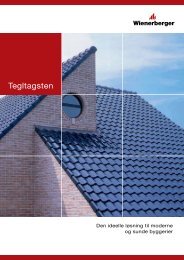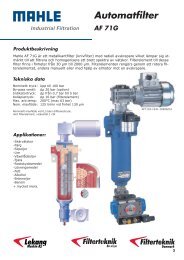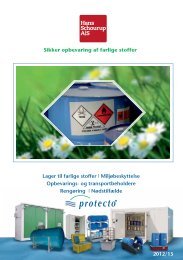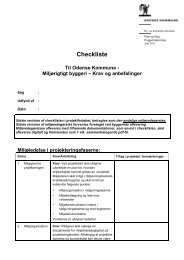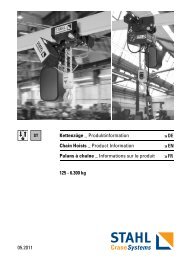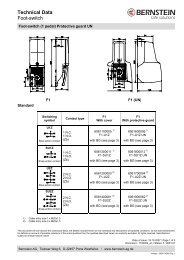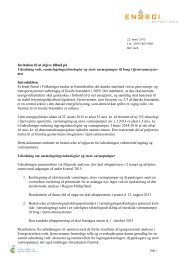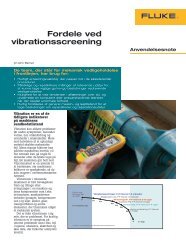Engineering plastics â The Manual - F.wood-supply.dk
Engineering plastics â The Manual - F.wood-supply.dk
Engineering plastics â The Manual - F.wood-supply.dk
You also want an ePaper? Increase the reach of your titles
YUMPU automatically turns print PDFs into web optimized ePapers that Google loves.
Mechanical properties<br />
σ R<br />
0<br />
σ B<br />
σ R<br />
σ S<br />
σ R<br />
Where plastic components are designed to withstand<br />
stress, the mechanical characteristics of a material have a<br />
particularly important role to play. <strong>The</strong> fundamental mechanical<br />
material properties include<br />
Δ σ<br />
Δ ε<br />
ˌˌStrength: dimension for the resistance<br />
of a material to external stress<br />
ˌˌFormability: the capacity of a material<br />
to become deformed under external stress<br />
ˌˌRigidity: ε R<br />
ε S dimension for the resistance ε B<br />
ε R<br />
ε R<br />
of a material to deformation<br />
ˌˌToughness: dimension for the energy absorption<br />
capacity of a material under external stress<br />
ˌˌTensile strength at yield σ S is the tensile stress at which<br />
the slope of the change of force versus length curve (see<br />
graph) equals zero for the first time.<br />
ε<br />
ˌˌElongation ε is the change in length Δ L in relation to the<br />
σ B original length L<br />
σ 0 of the specimen at any point during ε el(0)<br />
R<br />
σ testing. <strong>The</strong> elongation at maximum force is described<br />
S<br />
as ε B , elongation at break as ε R , tensile strength εat el(t)<br />
yield<br />
as ε S . ε = ε el(0)<br />
+ε el(t)<br />
+ε pl<br />
ˌˌModulus of elasticity E: A linear relationship can εonly pl be<br />
σ R<br />
observed in the lower range of the stress-strain diagram<br />
for <strong>plastics</strong>. In this range Hooke’s law applies, which<br />
says that the ratio of the stress and strain (modulus of<br />
elasticity) is constant. E = σ / ε in [MPa].<br />
ε<br />
σ<br />
S Strength<br />
F FormabilityF<br />
R Rigidity<br />
T Toughness<br />
V<br />
σ<br />
S<br />
F<br />
σ R<br />
0<br />
Δ σ<br />
ε S<br />
ε B<br />
ε R<br />
ε R<br />
Δ ε<br />
ε R<br />
Based on the bending, compression and impact toughness<br />
test, additional test methods are available for characterizing<br />
materials and different load cases.<br />
σ<br />
S<br />
R<br />
Z<br />
T<br />
ε<br />
0<br />
ε<br />
<strong>The</strong>se material characteristics are generally determined by<br />
briefly applying tensile load in one direction with a tensile<br />
test (for example in accordance with DIN EN ISO 527):<br />
σ<br />
brittle <strong>plastics</strong><br />
Source: J. Kunz, FHNW<br />
However, for the sound design of a component, the rele-<br />
application conditions F must also σ be taken into consid-<br />
S<br />
σvant<br />
eration: Because of their macromolecular structure, the<br />
V<br />
F<br />
mechanical properties of <strong>plastics</strong> depend heavily on the<br />
ambient conditions such as temperature, exposure period,<br />
S<br />
R<br />
type and velocity Z of loading and moisture content. T<br />
ε<br />
0<br />
ε<br />
σ B<br />
σ R<br />
Influences on forming behaviour<br />
σ S<br />
t<br />
ε<br />
ϑ<br />
tough hard <strong>plastics</strong><br />
ε<br />
Time<br />
σ<br />
ε<br />
Temperature<br />
σ<br />
σ R<br />
ε el(0)<br />
σ<br />
σ<br />
soft, elastic<br />
έ<br />
<strong>plastics</strong><br />
t<br />
ϑ<br />
ε el(t)<br />
Δ σ<br />
ε S<br />
ε B<br />
ε R<br />
ε R<br />
φ<br />
Δ ε ε R<br />
ε<br />
σ B Ultra-high tension<br />
σ R Tensile strength at break<br />
σ S Tensile strength at yield<br />
ε<br />
ε B Elongation under ultra-high tension<br />
ε R Elongation at break<br />
ε S Elongation at yield<br />
Moisture content<br />
σ<br />
ε<br />
ε = ε el(0)<br />
+ε el(t)<br />
+ε pl<br />
Velocity of load<br />
σ<br />
έ<br />
ε<br />
ε pl<br />
ˌˌTensile stress σ is the tensile force at the smallest<br />
σmeasured starting F cross-section of σthe test specimen S<br />
at any optional point in time during the test.<br />
V<br />
ˌˌTensile strength σ B is the tensile stress at maximum force.<br />
ˌˌTensile stress S at break σ R is the tensile stress Rat the<br />
Z<br />
T<br />
moment of break.<br />
F<br />
φ<br />
ε<br />
ε<br />
σ R<br />
0<br />
50<br />
ε<br />
0<br />
ε



